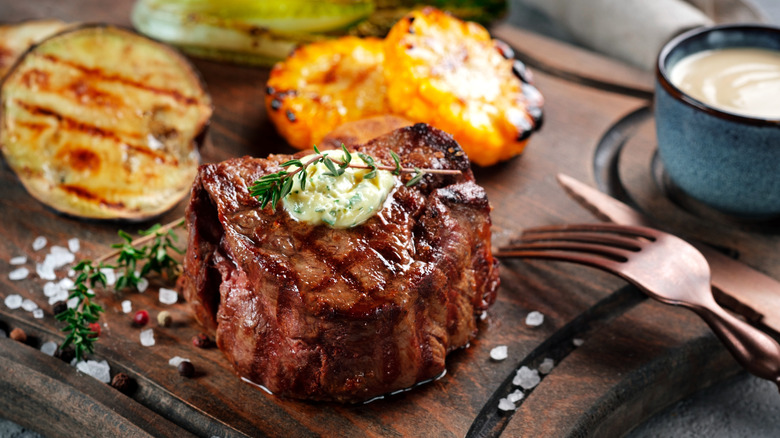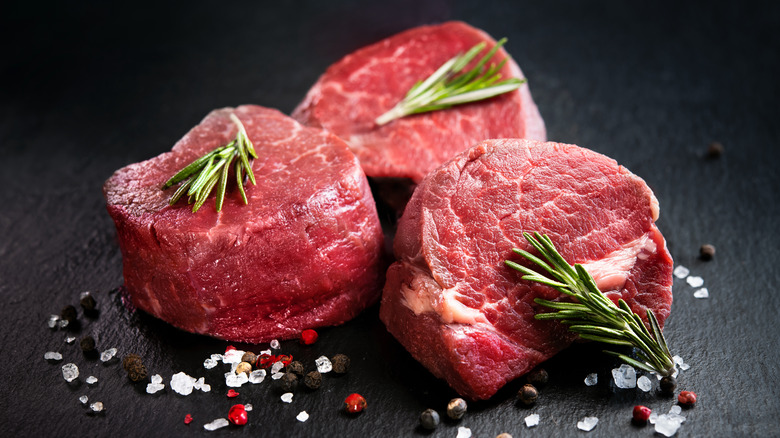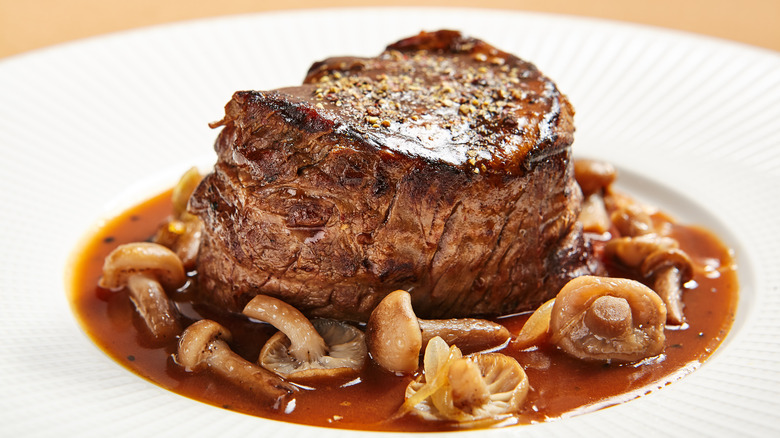The Crucial Question To Ask Your Waiter Before You Order Filet Mignon
You're in a restaurant you've never been to before. Looking over the menu, you can see that this particular restaurant offers filet mignon. This gives you some comfort — after all, no "bad" or "cheap" restaurant would serve something as ritzy as filet mignon, right? You put in an order for filet mignon, prepared however you like your steaks prepared, and ready for yourself for a good steak dinner. But imagine your surprise when, after taking the first bite of the filet, you notice something seems "off." You can't put your finger on it, but something about this filet mignon doesn't seem to add up.
Although filet mignon doesn't have as much beef flavor as some other steaks, it is mainly prized for its extreme tenderness (via MasterClass). Thanks to filet mignon's high price as a limited, high-quality cut of beef (via Allen Brothers), not every restaurant can afford to serve up filets the same as cheaper, more available cuts of steak. It's why you may think a restaurant is a bit more high-class when you see it serves filet mignon or wagyu beef on its menu.
But how sure can you be that the filet mignon you're getting is a "real" filet mignon? Could it be that what you're eating isn't a real filet mignon, but something designed to look like one?
Ask if your filet mignon is pre-formed
When you think of a cut of meat, such as a cut of steak in this case, you know that it's a part of the animal they cut it from. You can't exactly cobble together a porterhouse or a filet mignon, because they're whole cuts of meat. You can't exactly disguise a steak — or can you?
According to Reader's Digest, "transglutaminase" is a naturally occurring enzyme found in animals and humans that is known for being very good at bonding things together. It's this bonding ability that makes it a key "secret ingredient" in the culinary industry, where it's known as "meat glue." This "glue" is used in many applications, but most notably, it's used to take cheap scraps of meat and "glue" them together into a desired meat form — such as a filet mignon. Think of it like getting a bunch of leftovers, rolling and pounding them together, and calling the finished product a "homemade dinner."
Cornucopia, if it's to be believed, tells us that this method of "forming and re-forming" meat is common in the industry, from the kitchens of ritzy hotels to chain restaurants. By "gluing" meat scraps together in the shape of a filet mignon, restaurants can sell filet mignon for far cheaper than it would be to buy "whole" filets outright. The next time you're at a restaurant, maybe you should ask if your filet mignon is "whole" or "pre-formed" beforehand.
Is this meat glue dangerous?
While you may be miffed that you dropped a wad of cash on a filet mignon that was actually cheap scraps of beef that were hot-glued together, you may also be worried about the health implications. Is this "meat glue" any danger to you should you eat it?
According to the American Meat Institute, the United States Department of Agriculture and the Food and Drug Administration have both declared transglutaminase safe to use in cooking with both meat and non-meat-related dishes. The American Meat Institute also tells us that products made or produced with transglutaminase will have the enzyme included on the ingredients list and will have the words "formed" or "shaped" on the packaging, letting consumers know exactly what they're getting.
Although the USDA and FDA have gone on to say that "meat glue" is safe, others have not been so sure about the use of enzymes in the kitchen. According to ABC 7 News, in 2012, then-state Senator Ted Lieu of Los Angeles announced his belief that "meat glue" could cause harm to consumers, arguing that said government agencies should not only have stricter regulations on the use of transglutaminase but also consider the health consequences of binding different pieces of meat together.
In the end, as the use of "meat glue" is clearly put on the packaging of meat products, it seems like it's up to the consumer to make informed and conscious decisions about just what kind of meat they're actually eating.


